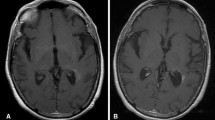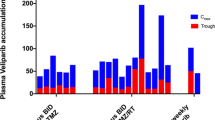Summary
Because the percentage of dividing cells in malignant glioma is small, cell cycle specific drugs such as VP16 are most effective if given continuously over prolonged periods. In this study, we chose a dose of 50 mg/day to minimize therapy interruptions for myelosuppresion. VP16 was given until the neutrophil count dropped to < 1.0 × 109/L or the platelets fell to < 75 × 109/L and resumed when the counts rose to normal levels. We treated 46 patients with supratentorial malignant glioma (15 anaplastic astrocytoma, 21 glioblastoma multiforme, 9 anaplastic oligodendroglioma, l undifferentiated primary malignant brain tumor) at the time of tumor progression. All had KPS ≥ 70 at study entry. All patients had prior RT,13 with adjuvant nitrosourea. Twenty-four had prior nitrosourea chemotherapy for tumor progression, 7 had no prior chemotherapy. We treated 20 patients with VP16 at first progression and 26 at second or later progression. All patients had CT or MR scans and clinical evaluation every 8 weeks. Median time to tumor progression (TTP) was 8.8 weeks for all evaluable patients, 8.6 weeks for those treated at first progression and 8.4 weeks for those treated at second progression, 9.1 weeks for anaplastic astrocytoma, 7.5 weeks for glioblastoma multiforme and 17.1 weeks for anaplastic oligodendroglioma. There were 8 responses and 11 patients with stable disease for at least 8 weeks (R + SD = 42%). Prolonged low-dose oral VP15 is well tolerated, with minimal myelosuppression. Prolonged low-dose oral VP16 is modestly effective treatment for patients with recurrent malignant glioma and is more effective for anaplastic astrocytoma and anaplastic oligodendroglioma than glioblastoma multiforme.
Similar content being viewed by others
References
Stewart DJ, Richard MT, Hugenholtz H, Dennery JM, Belanger R, Gerin-Lajoie J, Montpetit V, Nundy D, Prior J, Hopkins HS: Penetration of VP-16 (etoposide) into human intracerebral and extracerebral tumors. J Neuro-Oncol 2: 133–139, 1984
Tirelli U, D'Incaci M, Canetta R, Tumolo S, Franchin G, Veronesi A, Galligioni E, Trove, MG, Rossi C, Grigoletto E: Etoposide (VP-16–213) in malignant brain tumors: A phase II study. J Clin Oncol 2: 432–437, 1984
Fenn LG, Lee YY, Yung WKA, Savaraj N, Wallace S: Intracarotid VP-16 in malignant brain tumors. J Neuro-Oncol 4: 397–401, 1987
Radice PA, Bunn PA Jr, Ihde DC: Therapeutic trial with VP-16–213 and VM-26: Active agents in small cell lung cancer, non-Hodgkin's lymphomas, and other malignancies. Cancer Treat Rep 63: 1231–1239, 1979
Rosenczweig M, Von Hoff DD, Henney JE, Muggia FM: VM-26 and VP-16: a comparative analysis. Cancer 40: 334–342, 1977
Gerosa MA, DiStefano E, Olivi A: VM-26 monochemotherapy trial in the treatment of recurrent supratentorial gliomas: preliminary report. Surgical Neurology 15: 128–134, 1981
Kessinger A, Lemon HM, Foley JF: VM-26 as a second drug in the treatment of brain gliomas. Cancer Treat Rep 63: 511–512, 1979
Sklansky BD, Mann-Kaplan RS, Reynolds AF Jr, Rosenblum ML, Walker MD: 4″-demethyl-epipodophyllotoxinB-D-Trenylidene-glucoside (PTG) in the treatment of malignant intracranial neoplasms. Cancer 33: 460–467, 1974
Hoshino T, Wilson CB: Cell kinetic analyses of human malignant brain tumor (gliomas). Cancer 44: 956–962, 1979
Morimura T, Kitz K, Budka H: In situ analysis of cell kinetics in human brain tumors. Acta Neuropathol 77: 276–282, 1989
Raghavan R, Steart PV, Weller RO: Cell proliferation patterns in the diagnosis of anaplastic astrocytomas and glioblastoma multiforme: a ki-67 study. Neuropathol Appl Neurobiol 16: 123–133, 1990
Greco FZ, Johnson DH, Hainsworth JD: Chronic oral etoposide. Cancer 67: 303–309, 1991
Greco FA: Future directions for etoposide therapy. Cancer 67 (1 Suppl): 315–318, 1991
Aisner J, Lee EJ: Etoposide. Current and future status. Cancer 67 (1 Suppl): 215–219, 1991
Chamberlain MC: Recurrent brainstem gliomas treated with oral VP-16. J Neuro-Oncology 15: 133–139, 1993
Minami H, Ando Y, Sakai S, Shimokata K: Clinical and pharmacologic analysis of hyperfractionated daily oral etoposide. J Clin Oncol 13: 191–199, 1995
Kiya K, Uozimi T, Ogasawara H, Sugiyama K, Hotta T, Mikami T, Kurisu K: Penetration of etoposide into human malignant brain tumors after intravenous and oral administration. Cancer Chemother Pharmacol 29: 339–342, 1992
Author information
Authors and Affiliations
Rights and permissions
About this article
Cite this article
Fulton, D., Urtasun, R. & Forsyth, P. Phase II study of prolonged oral therapy with etoposide (VP16) for patients with recurrent malignant glioma. J Neuro-Oncol 27, 149–155 (1996). https://doi.org/10.1007/BF00177478
Issue Date:
DOI: https://doi.org/10.1007/BF00177478




